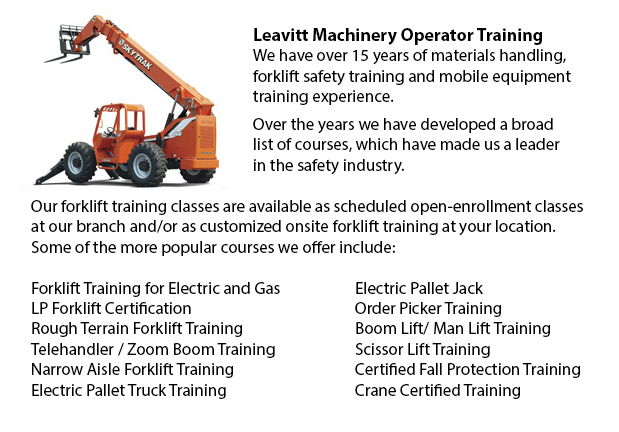
Oakville Telescopic Training - Telescopic Handlers are a type of forklift, often known as telehandlers. This equipment has been increasing in popularity due to its versatility and its greater lift heights. It is often preferred over the conventional masted counterbalance truck (standard and rough terrain). Whether used for transporting pallets within a warehouse or for transporting raw materials into the back of a dump truck, the telescopic forklift is an essential machinery. Accredited telescopic handler training is important to ensure the safe and efficient use of the unit.
A telescopic forklift is designed to lift heavy items using an arm, which extends in segments much like a telescope. To choose a telescopic forklift, you need to consider how the machinery would be used and for how long. Required lift heights and work site terrain must be considered. Parts, cost and warranty are all factors involved in buying a telescopic forklift. If you are leasing, you will want to compare prices, terms and delivery costs.
This type of lift truck is available in various sizes, that directly reflects the amount of weight it could load and the heights it can safely lift products to. If the task is to transport materials into the rear of a pick-up then a small to medium sized telescopic forklift is ideal. Lifting heavier things up higher would require a larger lift. Careful consideration of how the lift would be utilized helps ensures you would choose the best size for stability and safety.
Attachments are one more consideration when selecting machinery. Ask what attachments are offered from the manufacturer. There are pallet attachments, bucket attachments as well as various attachments used for specific reasons.
Work site terrain influences the selection of tires for the telehandler. Cushion tires are made of rubber all the way through, and are found on smaller units. Cushion tires are appropriate for telehandlers being utilized inside a warehouse with a concrete floor. They provide stability and durability. Pneumatic tires are usually on larger units utilized on varied, outdoor terrain where there might be rock, dirt, concrete and asphalt. They provide the best traction and articulation.
-
Oakville Overhead Crane Safety Training
Oakville Overhead Crane Safety Training - Overhead crane safety training equips operators with skills and knowledge regarding crane safety measures, accident avoidance, materials handling, and machinery and stock protection. Trainees will learn the t... More -
Oakville Crane Training Schools
Oakville Crane Training Schools - Our various Mobile Crane Operation programs are designed for skilled operators who needs re-certification or certification, and for inexperienced individuals who are seeking their very first job as an operator of a c... More -
Oakville Overhead Crane Certification
Oakville Overhead Crane Certification - The overhead crane certification course is a course that is designed to help trainees, even though they have language or literacy limits. The course consists of a classroom theory part and a practical hands-on... More -
Oakville Forklift Training Programs
Oakville Forklift Training Programs - If you are searching for work as an operator of a forklift, our regulatory-compliant forklift training programs provide exceptional instruction in various types and styles of forklifts, classes on pre-shift inspe... More -
Oakville Fall Protection Ticket
Oakville Fall Protection Ticket - The number one cause of death in the construction business come from fall-related accidents. There is more possibility for fall accidents depending on the types of work being performed within your workplace. Thus, be... More -
Oakville Zoom Boom Training
Oakville Zoom Boom Training - Zoom Boom Training focuses on correctly training potential operators on variable reach forklifts. The training objectives consist of gaining the understanding of the machine's physics and to define the job of the operato... More -
Oakville Aerial Lift Ticket
Oakville Aerial Lift Ticket - A boom truck is often recognized by the cable and telephone company vans that have the elongated arm folded over their roofs. Commonly, a bucket-like apparatus sits at the extension of extendable arms. Often referred to... More -
Oakville Scissor Lift Training
Oakville Scissor Lift Training - Scissor lifts need to be operated competently to be able to protect the safety of the machinery and the safety of people in the workplace. Operators who are skilled are trained to drive the specific model of scissor l... More

Forklift Certification Oakville
TOLL FREE: 1-888-254-6157
Oakville, Ontario
forkliftcertificationoakville.com
Email Us
About Us


